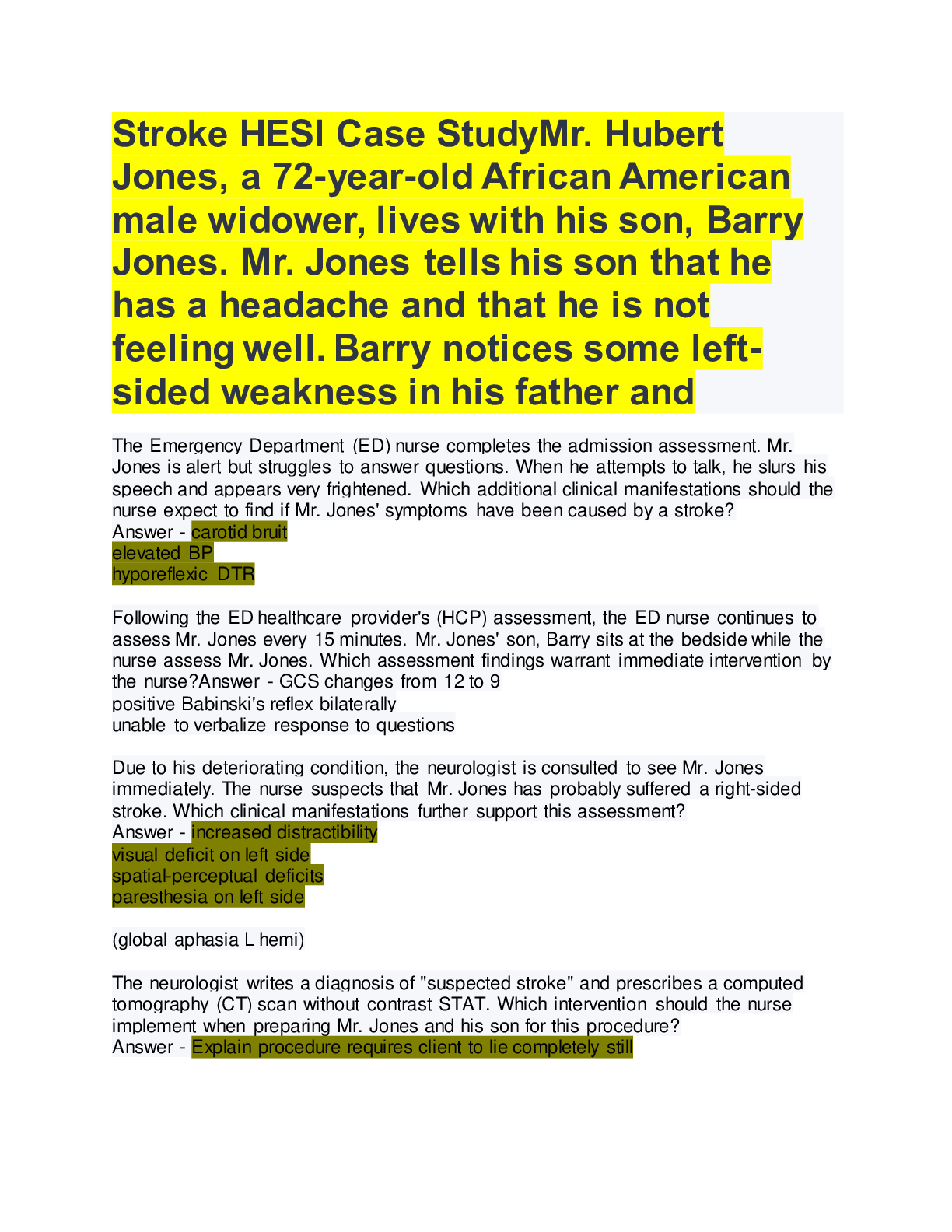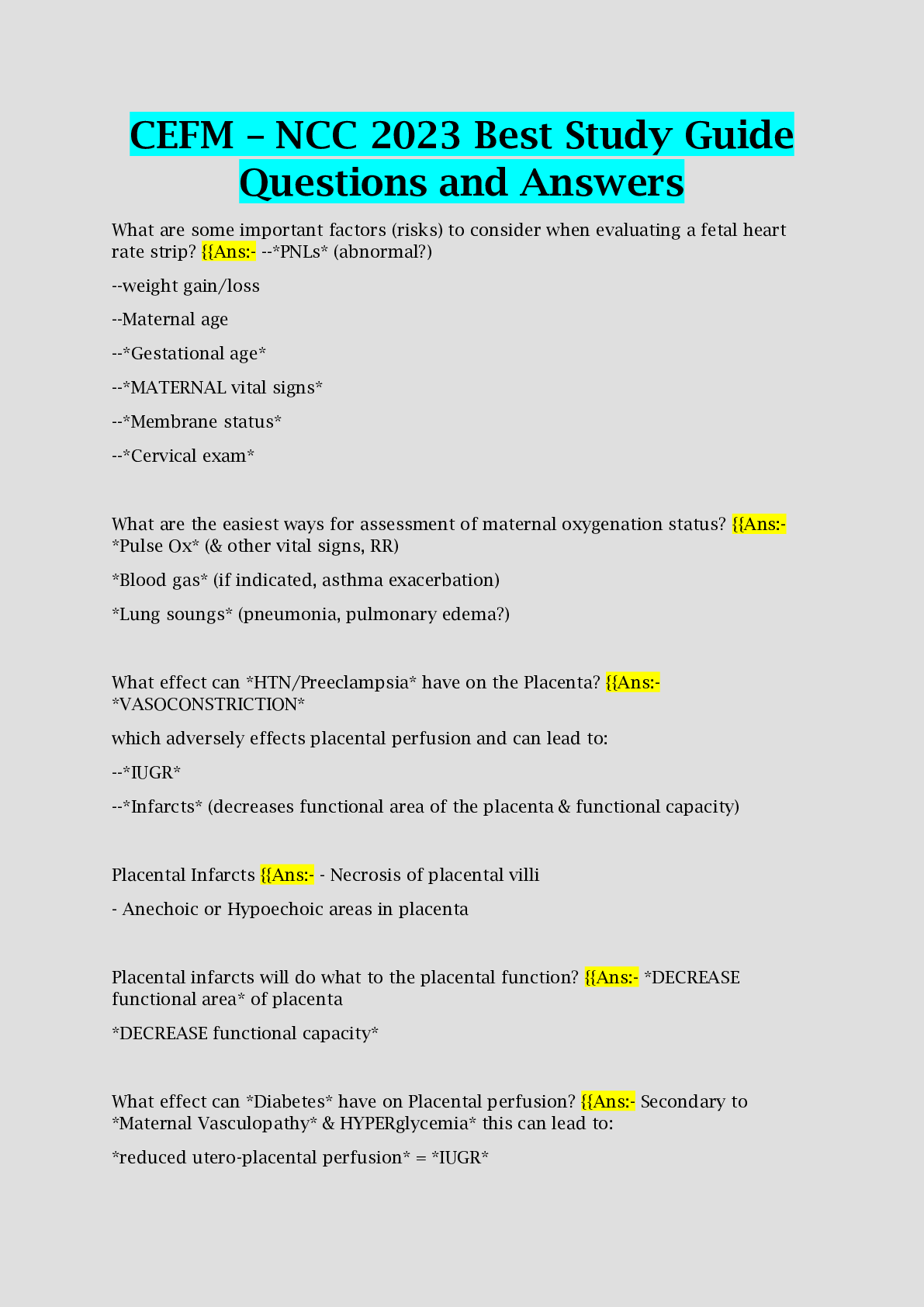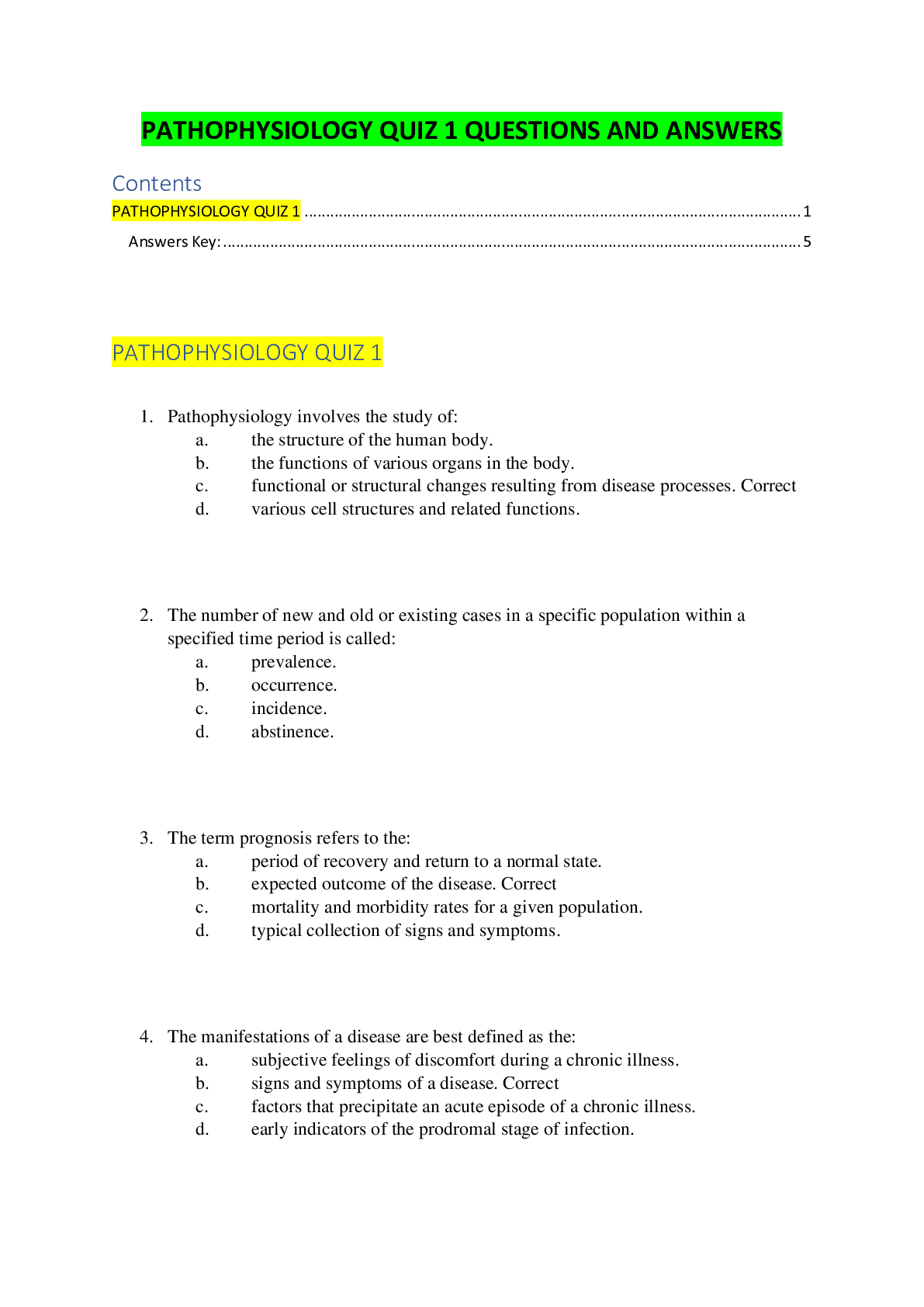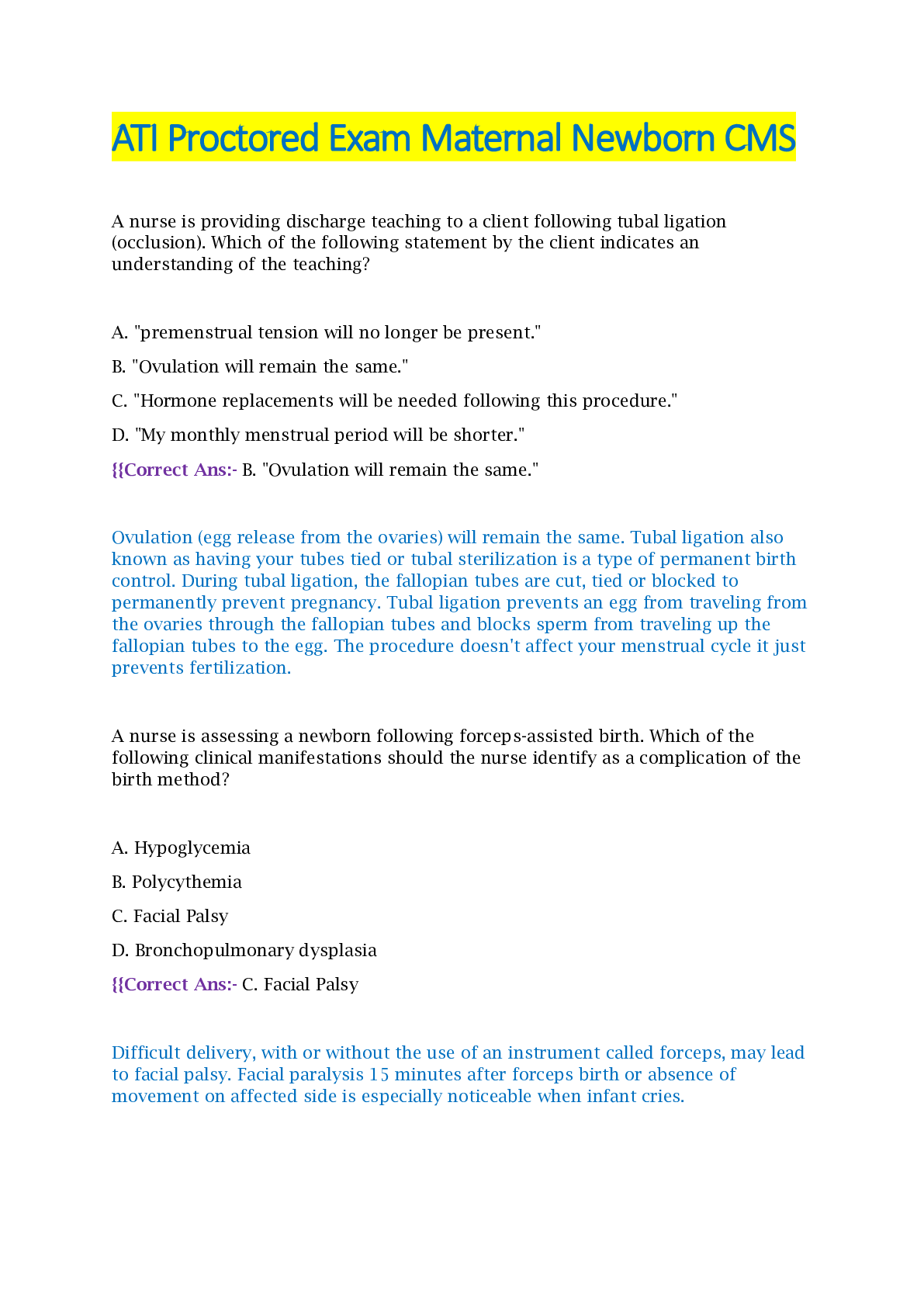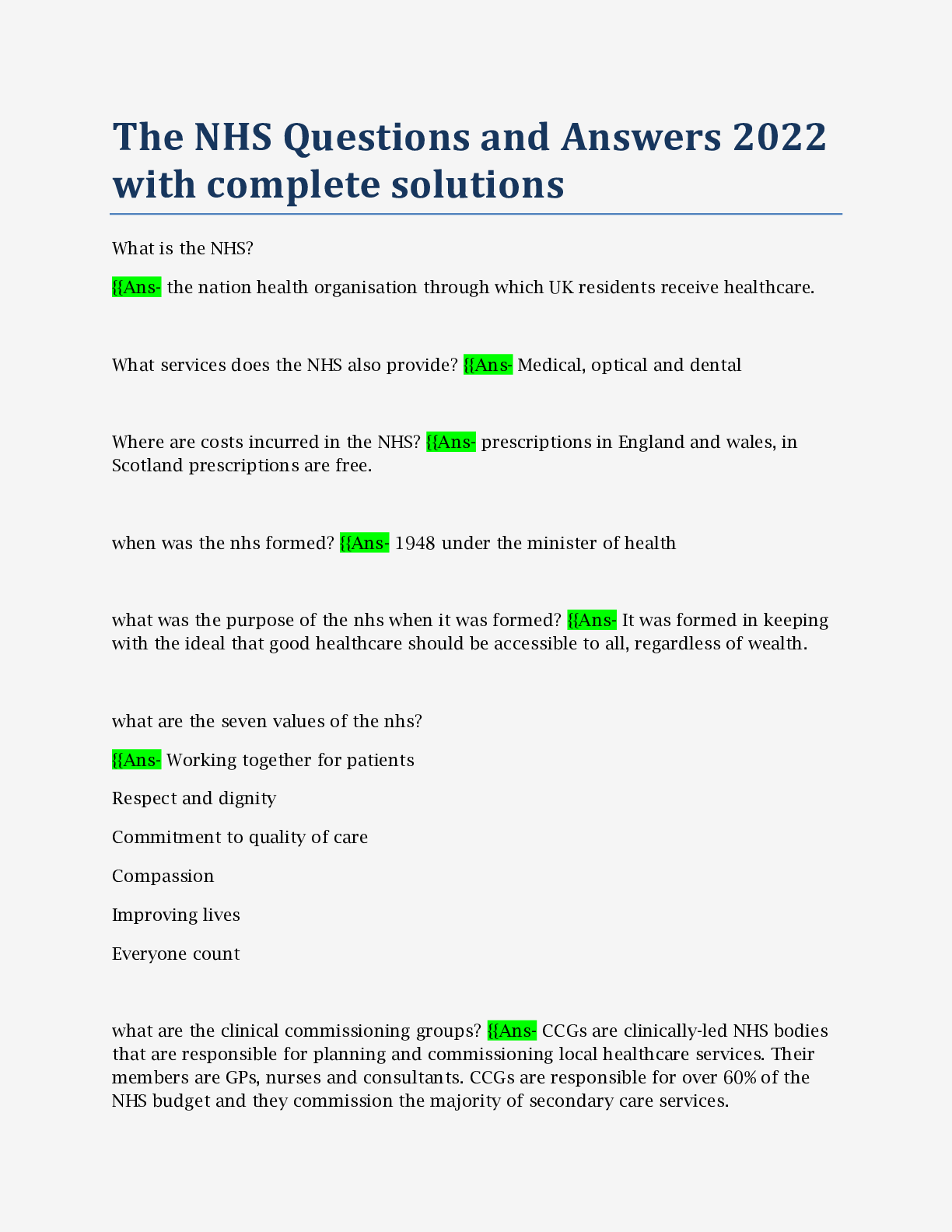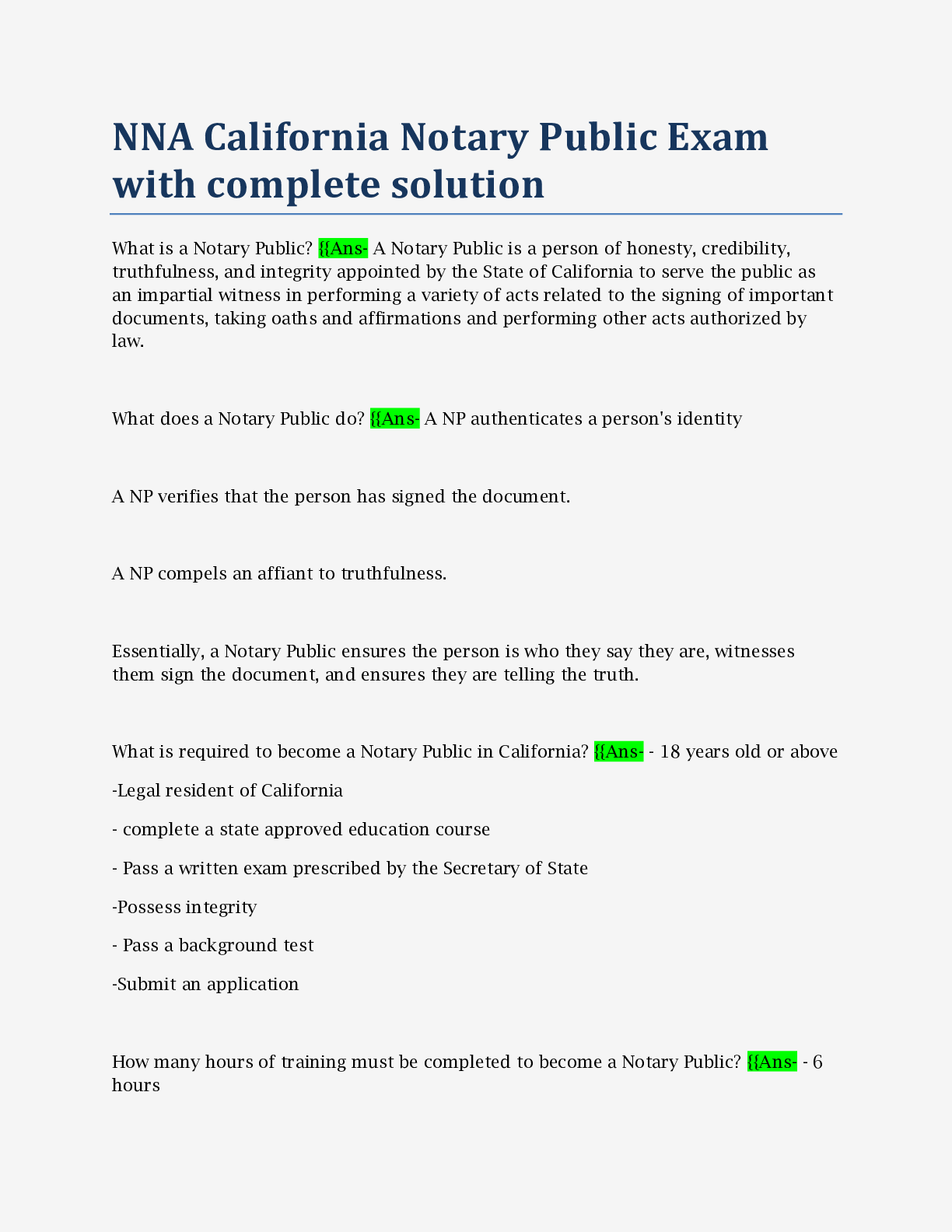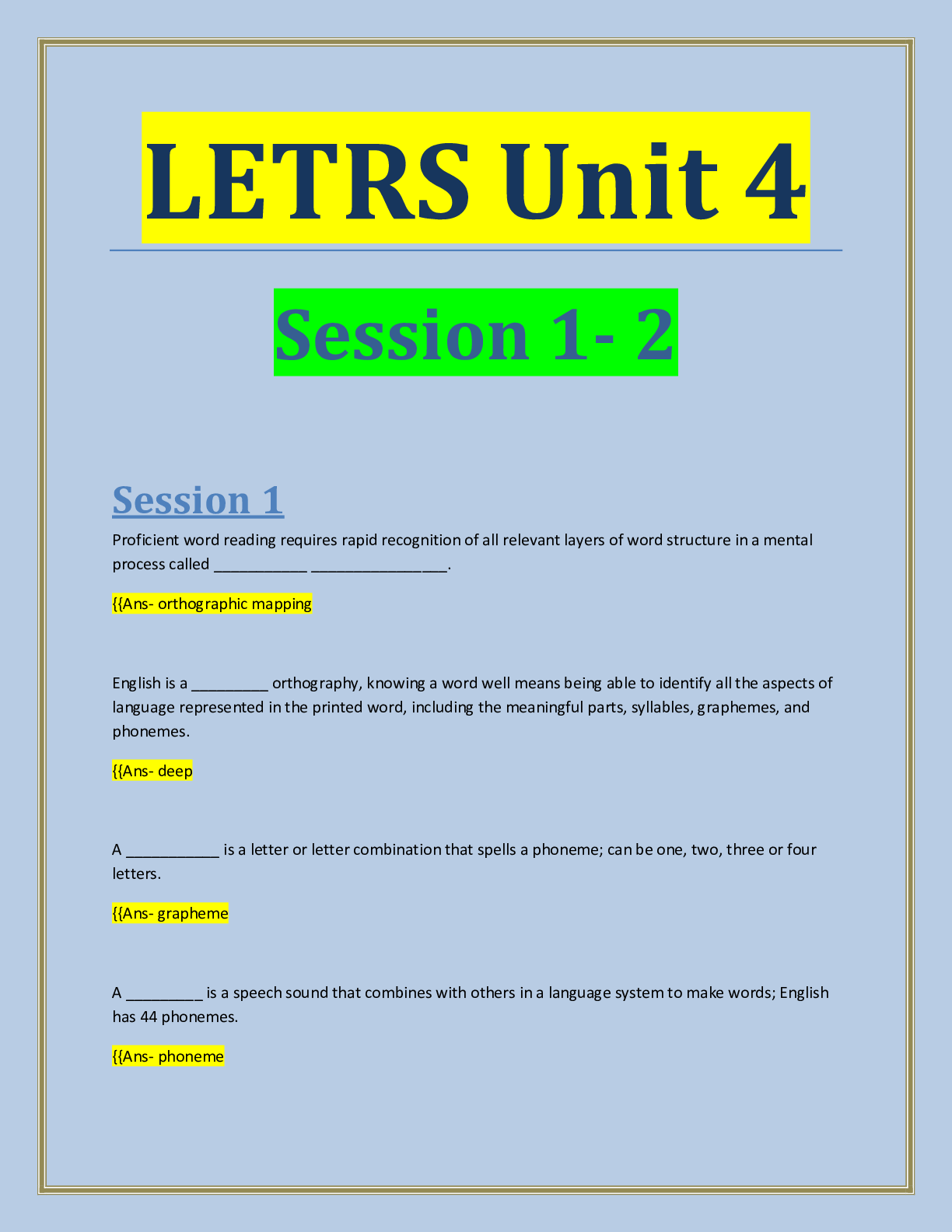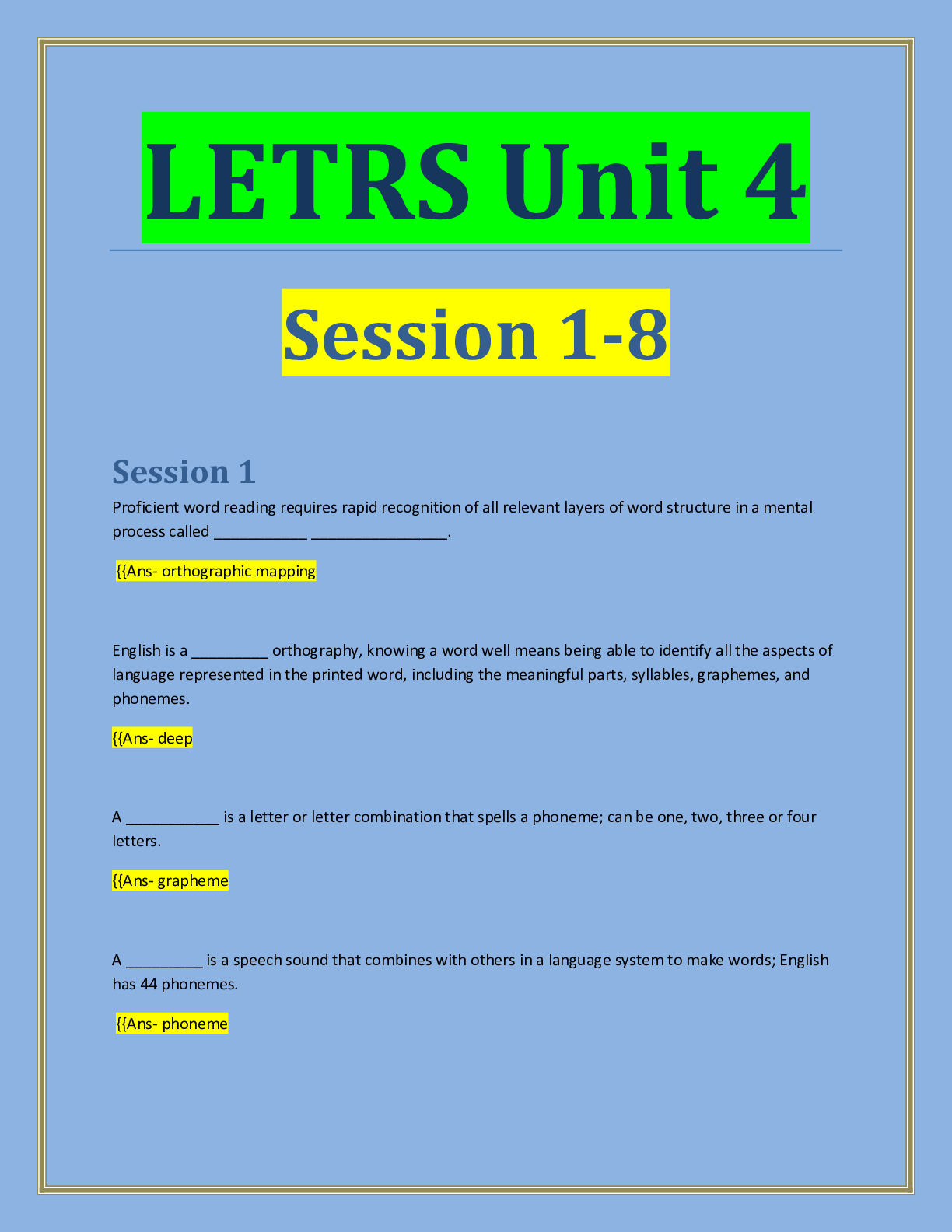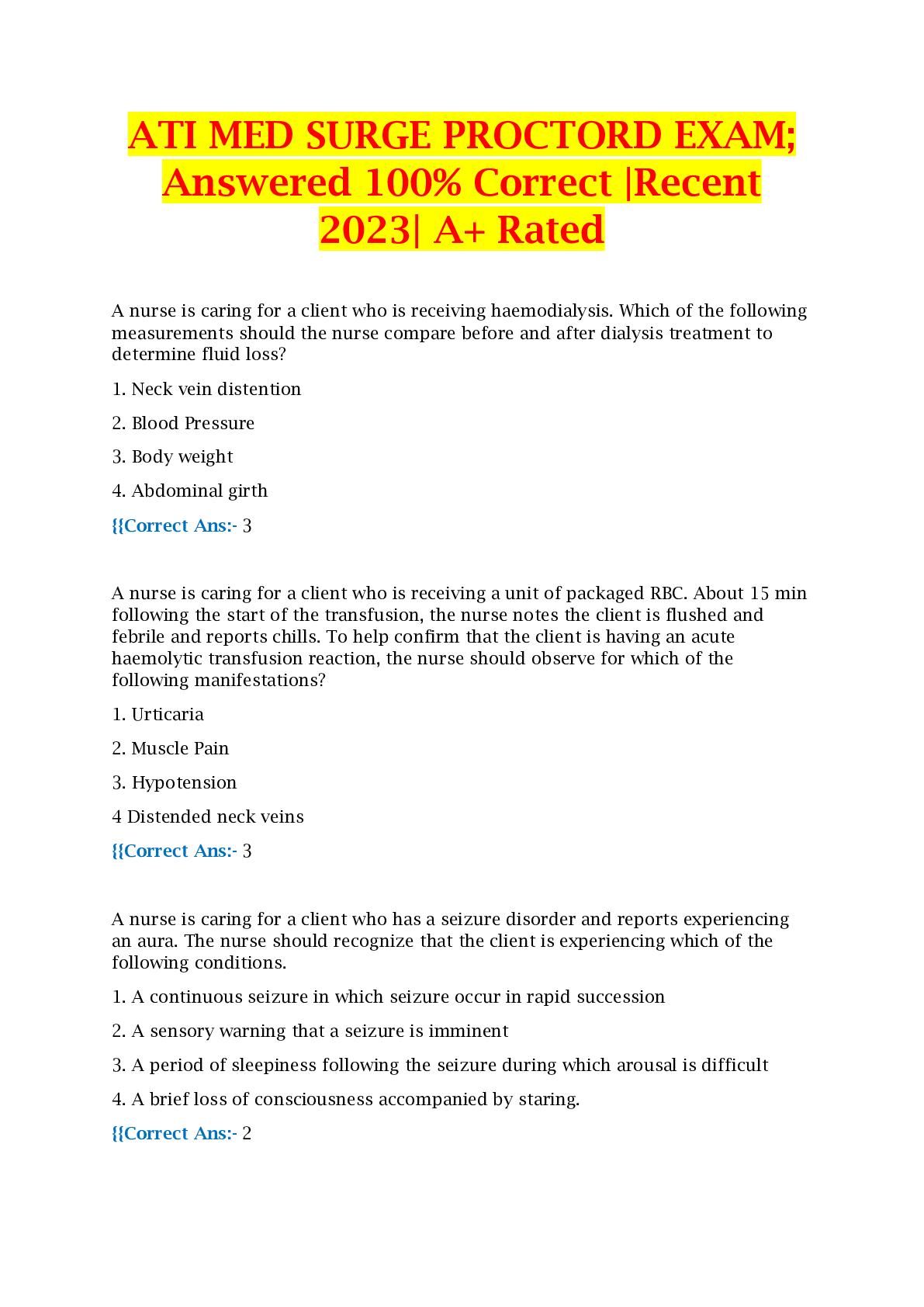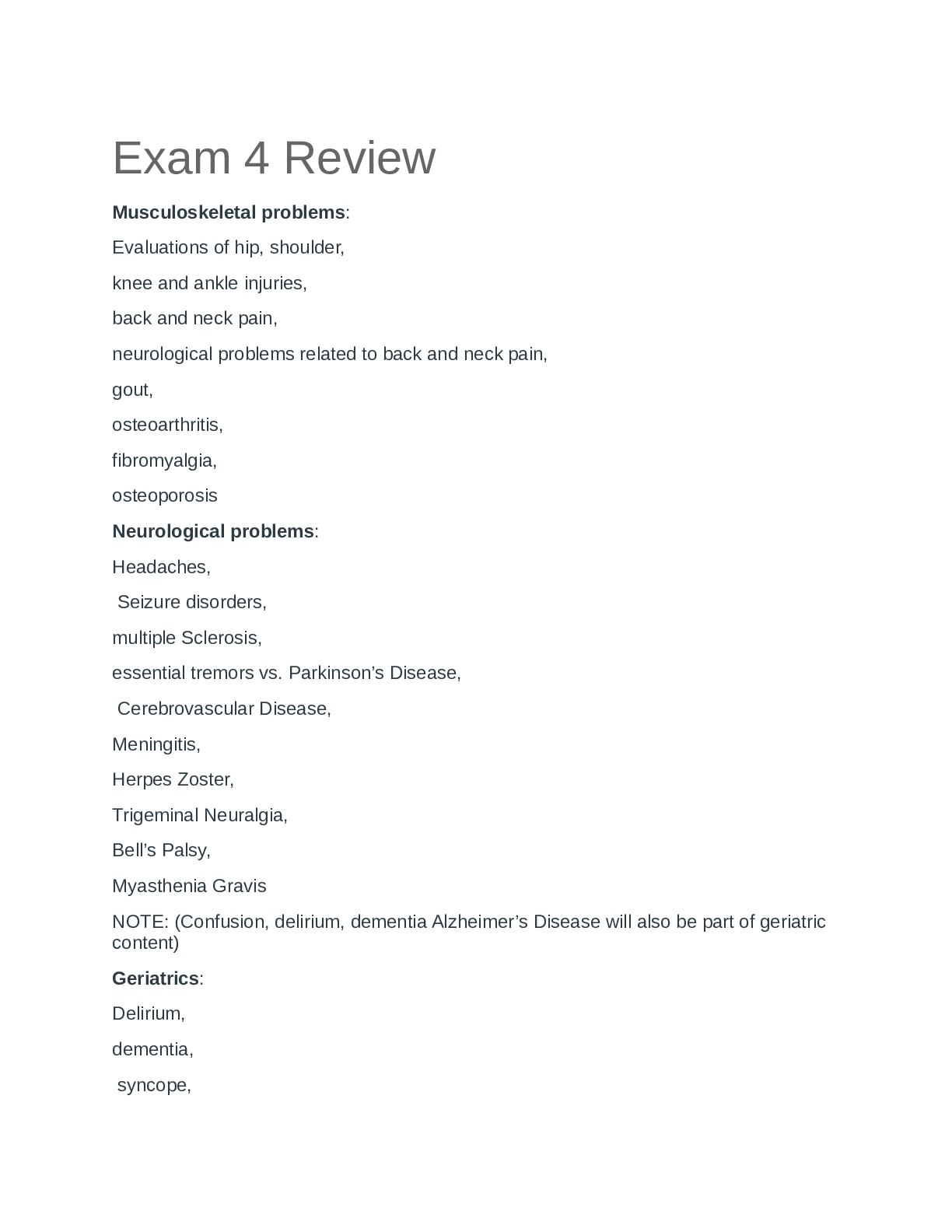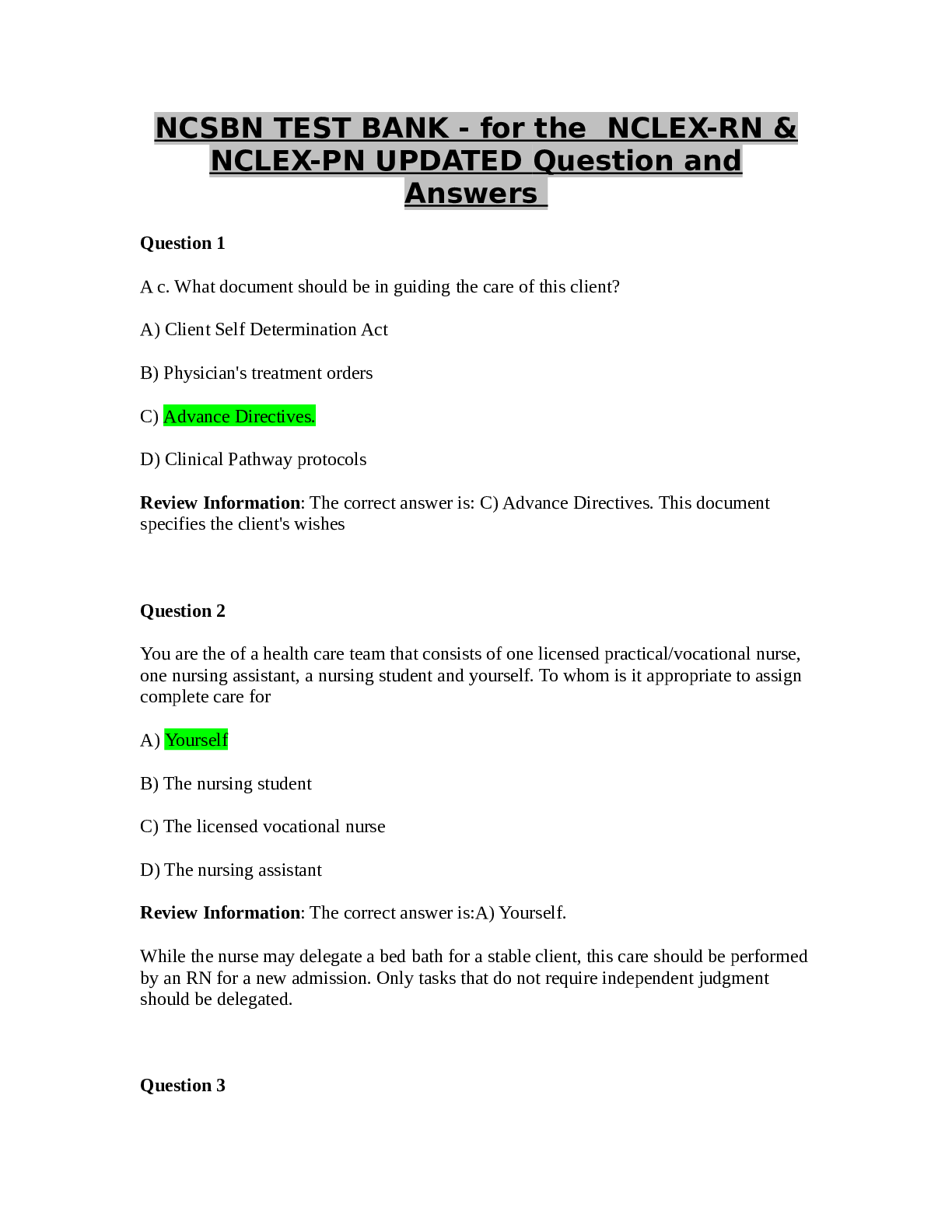*NURSING > EXAM > Final MS Acute Exam Questions and Answers 2022/2023|Test Bank complete solutions (All)
Final MS Acute Exam Questions and Answers 2022/2023|Test Bank complete solutions
Document Content and Description Below
Final MS Acute Exam Questions and Answers 2022/2023|Test Bank complete solutions Which question asked by the nurse will give the most information about the patient's metastatic bone cancer pain? a... . "How long have you had this pain?" b. "How would you describe your pain?" c. "How often do you take pain medication?" d. "How much medication do you take for the pain?" - ANS: B Because pain is a multidimensional experience, asking a question that addresses the patient's experience with the pain will elicit more information than the more specific information asked in the other three responses. All of these questions are appropriate, but the response beginning "How would you describe your pain?" is the best initial question A patient who has had good control for chronic pain using a fentanyl (Duragesic) patch reports rapid onset pain at a level 9 (0 to 10 scale) and requests "something for pain that will work quickly." How will the nurse document the type of pain reported by this patient? a. Somatic pain b. Referred pain c. Neuropathic pain d. Breakthrough pain - ANS: D Pain that occurs beyond the chronic pain already being treated by appropriate analgesics is termed breakthrough pain. Neuropathic pain is caused by damage to peripheral nerves or the central nervous system. Somatic pain is localized and arises from bone, joint, muscle, skin, or connective tissue. Referred pain is pain that is localized in uninjured tissue. The nurse teaches a student nurse about the action of ibuprofen. Which statement, if made by the student, indicates that teaching was effective? a."The drug decreases pain impulses in the spinal cord." b."The drug decreases sensitivity of the brain to painful stimuli." c."The drug decreases production of pain-sensitizing chemicals." d."The drug decreases the modulating effect of descending nerves." - ANS: C Nonsteroidal antiinflammatory drugs (NSAIDs) provide analgesic effects by decreasing the production of pain-sensitizing chemicals such as prostaglandins at the site of injury. Transmission of impulses through the spinal cord, brain sensitivity to pain, and the descending nerve pathways are not affected by NSAIDs. A nurse assesses a patient with chronic cancer pain who is receiving imipramine (Tofranil) in addition to long-acting morphine (MS Contin). Which statement, if made by the patient, indicates to the nurse that the patient is receiving adequate pain control? a."I'm not anxious during the day." b."Every night I get 8 hours of sleep." c."I can accomplish activities without much discomfort." d."I feel less depressed since I've been taking the Tofranil." - ANS: C Imipramine is being used in this patient to manage chronic pain and improve functional ability. Although the medication is also prescribed for patients with depression, insomnia, and anxiety, the evaluation for this patient is based on improved pain control and activity level. DIF: Cognitive Level: Apply (application) REF: 116 TOP: Nursing Process: Evaluation MSC: NCLEX: Physiological Integrit A patient with chronic back pain has learned to control the pain with the use of imagery and hypnosis. The patient's spouse asks the nurse how these techniques work. Which response by the nurse is accurate? a. "The strategies work by affecting the perception of pain." b. "These techniques block the pain pathways of the nerves." c. "These strategies prevent transmission of stimuli from the back to the brain." d. "The therapies slow the release of chemicals in the spinal cord that cause pain." - ANS: A Cognitive therapies affect the perception of pain by the brain rather than affecting efferent or afferent pathways or influencing the release of chemical transmitters in the dorsal horn. DIF: Cognitive Level: Apply (application) REF: 121 TOP: Nursing Process: Implementation MSC: NCLEX: Physiological Integrity A patient who is receiving sustained-release morphine sulfate (MS Contin) every 12 hours for chronic pain experiences level 9 (0 to 10 scale) breakthrough pain and anxiety. Which action by the nurse is appropriate for treating this change in assessment? a. Suggest amitriptyline 10 mg orally. b. Administer lorazepam (Ativan) 1 mg orally. c. Give ibuprofen (Motrin) 400 to 800 mg orally. d. Offer immediate-release morphine 30 mg orally. - ANS: D The severe breakthrough pain indicates that the initial therapy should be a rapidly acting opioid, such as the immediate-release morphine. Lorazepam and amitriptyline may be appropriate to use as adjuvant therapy, but they are not likely to block severe breakthrough pain. Use of antianxiety agents for pain control is inappropriate because this patient's anxiety is caused by the pain. DIF: Cognitive Level: Apply (application) REF: 108 TOP: Nursing Process: Implementation MSC: NCLEX: Physiological Integrity A patient with chronic neck pain is seen in the pain clinic for follow-up. To evaluate whether the pain management is effective, which question is best for the nurse to ask? a."Has there been a change in pain location?" b."Can you describe the quality of your pain?" c."How would you rate your pain on a 0 to 10 scale?" d."Does the pain keep you from activities that you enjoy?" - ANS: D The goal for the treatment of chronic pain usually is to enhance function and quality of life. The other questions are also appropriate to ask, but information about patient function is more useful in evaluating effectiveness A patient with a deep partial thickness burn has been receiving hydromorphone through Patient-controlled analgesia (PCA) for 1 week. The nurse caring for the patient during the Previous shift reports that the patient wakes up frequently during the night complaining of Pain. What action by the nurse is appropriate? a.Administer a dose of morphine every 1 to 2 hours from the PCA machine while the patient is sleeping. b.Consult with the health care provider about using a different treatment protocol to control the patient's pain. c.Request that the health care provider order a bolus dose of morphine to be given when the patient awakens with pain. d.Teach the patient to push the button every 10 minutes for an hour before going to sleep, even if the pain is minimal. - ANS: B PCAs are best for controlling acute pain. This patient's history indicates a need for a pain management plan that will provide adequate analgesia while the patient is sleeping. Administering a dose of morphine when the patient already has severe pain will not address the problem. Teaching the patient to administer unneeded medication before going to sleep can result in oversedation and respiratory depression. It is illegal for the nurse to administer the morphine for a patient through PCA. DIF: Cognitive Level: Apply (application) REF: 107 TOP: Nursing Process: Implementation MSC: NCLEX: Physiological Integrity allodynia - sensation of pain in response to a stimulus that would not typically produce pain The nurse assesses that a patient receiving epidural morphine has not voided for more than 10 hours. What action should the nurse take initially? a.Place an indwelling urinary catheter. b.Monitor for signs of narcotic overdose. c.Ask if the patient feels the need to void. d.Encourage the patient to drink more fluids. - ANS: C Urinary retention is a common side effect of epidural opioids. Assess whether the patient feels the need to void. Because urinary retention is a possible side effect, there is no reason for concern of overdose symptoms. Placing an indwelling catheter requires an order from the health care provider. Usually an in-and-out catheter is performed to empty the bladder if the patient is unable to void because of the risk of infection with an indwelling catheter. Encouraging oral fluids may lead to bladder distention if the patient is unable to void, but might be useful if a patient who is able to void has a fluid deficit. DIF: Cognitive Level: Apply (application) REF: 114 OBJ: Special Questions: Prioritization TOP: Nursing Process: Implementation MSC: NCLEX: Physiological Integrity The nurse assesses that a home hospice patient with terminal cancer who complains of severe pain has a respiratory rate of 11 breaths/min. Which action should the nurse take? a.Inform the patient that increasing the morphine will cause the respiratory drive to fail. b.Tell the patient that additional morphine can be administered when the respirations are 12. c.Titrate the prescribed morphine dose up until the patient indicates adequate pain relief. d.Administer a nonsteroidal antiinflammatory drug (NSAID) to improve patient pain control. - ANS: C The goal of opioid use in terminally ill patients is effective pain relief regardless of adverse effects such as respiratory depression. A nonopioid analgesic such as ibuprofen would not provide adequate analgesia or be absorbed quickly. The rule of double effect provides ethical justification for administering an increased morphine dose to provide effective pain control even though the morphine may further decrease the patient's respiratory rate. DIF: Cognitive Level: Apply (application) REF: 125 TOP: Nursing Process: Implementation MSC: NCLEX: Physiological Integrity The nurse is completing the medication reconciliation form for a patient admitted with chronic cancer pain. Which medication is of most concern to the nurse? a.Amitriptyline 50 mg at bedtime b.Ibuprofen 800 mg 3 times daily c.Oxycodone (OxyContin) 80 mg twice daily d.Meperidine (Demerol) 25 mg every 4 hours - ANS: D Meperidine is contraindicated for chronic pain because it forms a metabolite that is neurotoxic and can cause seizures when used for prolonged periods. The ibuprofen, amitriptyline, and oxycodone are appropriate medications for long-term pain management. DIF: Cognitive Level: Apply (application) REF: 114 TOP: Nursing Process: Assessment MSC: NCLEX: Physiological Integrity Which medication should the nurse administer for a patient with cancer who describes the pain as "deep, aching and at a level 8 on a 0 to 10 scale"? TestBankWorld.org a.Ketorolac tablets b.Fentanyl (Duragesic) patch c.Hydromorphone (Dilaudid) IV d.Acetaminophen (Tylenol) suppository - ANS: C The patient's pain level indicates that a rapidly acting medication such as an IV opioid is needed. The other medications may also be appropriate to use but will not work as rapidly or as effectively as the IV hydromorphone. DIF: Cognitive Level: Apply (application) REF: 112 TOP: Nursing Process: Implementation MSC: NCLEX: Physiological Integrity 13. The nurse is caring for a patient who has diabetes and complains of chronic, burning leg pain even when taking oxycodone (OxyContin) twice daily. Which prescribed medication is the best choice for the nurse to administer as an adjuvant to decrease the patient's pain? a.Aspirin b.Celecoxib (Celebrex) c.Amitriptyline d.Acetaminophen (Tylenol) - ANS: C The patient's pain symptoms are consistent with neuropathic pain and the tricyclic antidepressants are effective for treating this type of pain. The other medications are more effective for nociceptive pain. DIF: Cognitive Level: Apply (application) REF: 106 TOP: Nursing Process: Implementation MSC: NCLEX: Physiological Integrity A patient who uses a fentanyl (Duragesic) patch for chronic abdominal pain caused by ovarian cancer asks the nurse to administer the prescribed hydrocodone tablets, but the patient is asleep when the nurse returns with the medication. Which action is best for the nurse to take? a.Wake the patient and administer the hydrocodone. b.Wait until the patient wakes up and reassess the pain. c.Suggest the use of nondrug therapies for pain relief instead of additional opioids. d.Consult with the health care provider about changing the fentanyl (Duragesic) dose. - ANS: A Because patients with chronic pain frequently use withdrawal and decreased activity as coping mechanisms for pain, sleep is not an indicator that the patient is pain free. The nurse should wake the patient and administer the hydrocodone. DIF: Cognitive Level: Apply (application) REF: 107 TOP: Nursing Process: Implementation MSC: NCLEX: Physiological Integrity [Show More]
Last updated: 2 years ago
Preview 1 out of 119 pages
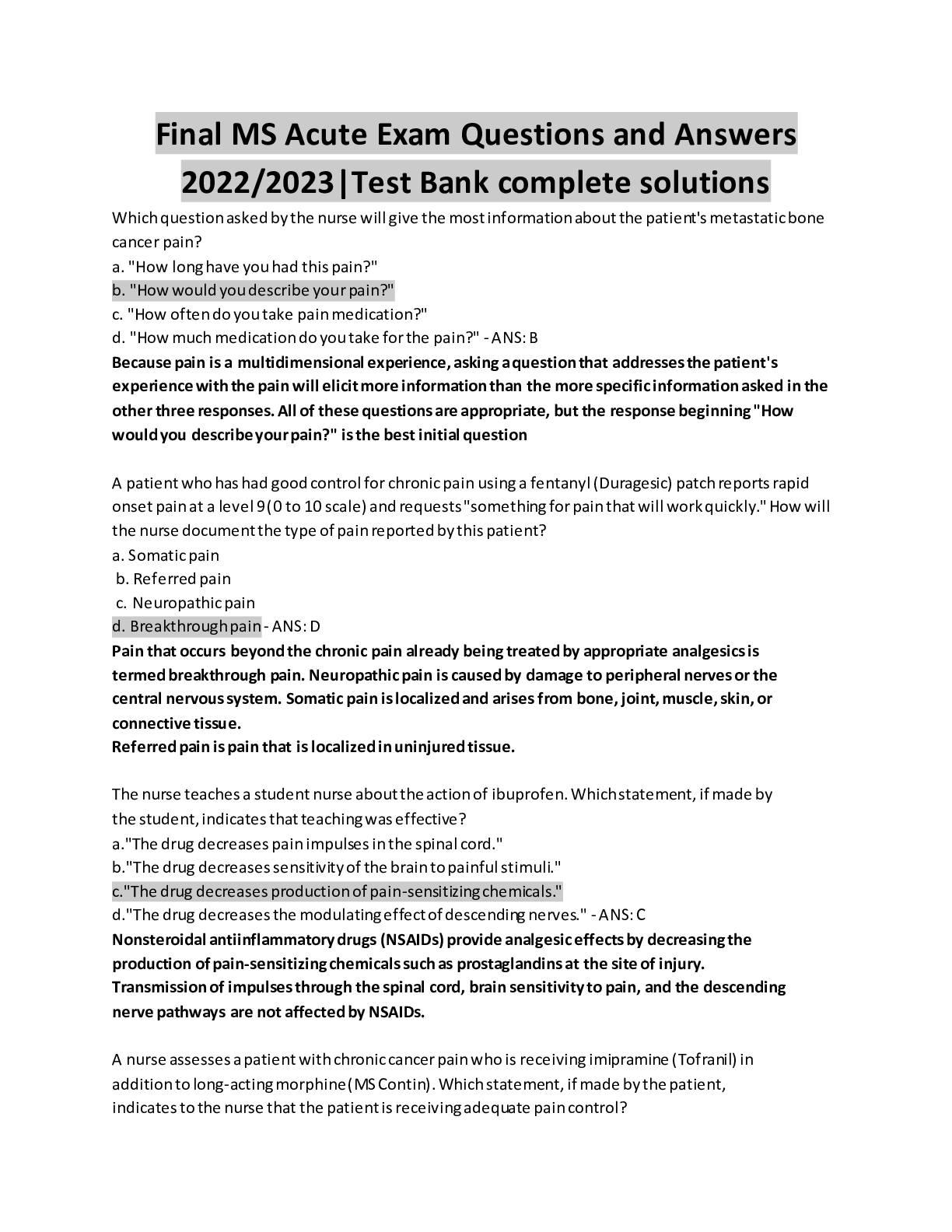
Buy this document to get the full access instantly
Instant Download Access after purchase
Buy NowInstant download
We Accept:

Reviews( 0 )
$13.00
Can't find what you want? Try our AI powered Search
Document information
Connected school, study & course
About the document
Uploaded On
Jul 01, 2022
Number of pages
119
Written in
Additional information
This document has been written for:
Uploaded
Jul 01, 2022
Downloads
0
Views
85

